I ended up visiting Cambodia and in turn Siem Reap several times after that. When in Siem Reap, a visit to Angkor Wat was inevitable and each of my visits only lured me more and more. While there are hundreds of temples in this architectural treasure trove, the highlight definitely is the Angkor Wat Temple. Also being a UNESCO World Heritage site, it is one of the most famous destinations and on every traveler's bucket list. While the common denominator for over 2 million tourists visiting every year is to admire its grandeur and learn about its rich history, I believe that this sacred and historic place speaks to each one in a unique way creating one-of-a-kind individual experiences.
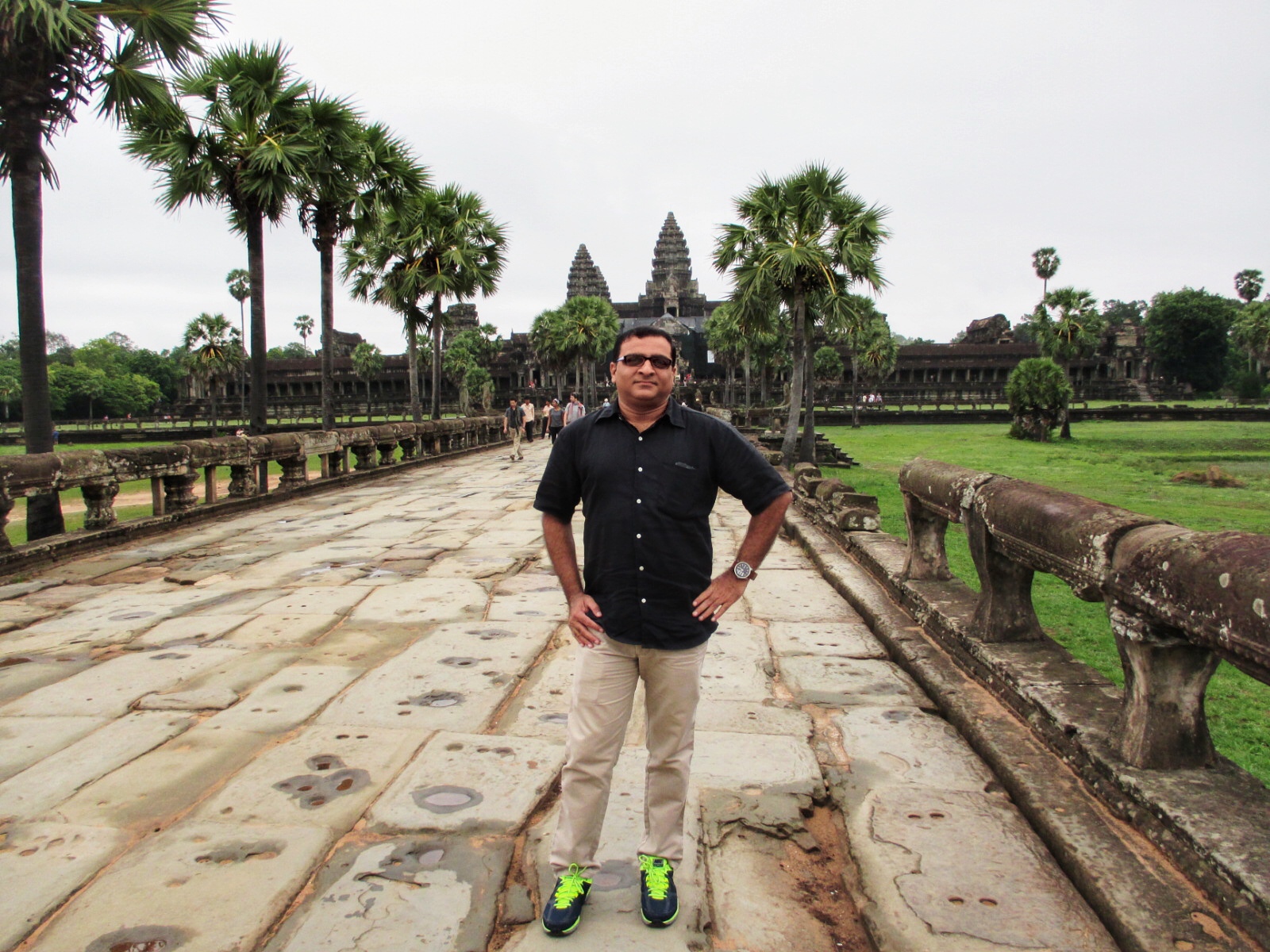
I was thrilled to have finally made it to Angkor Wat, truly blessed
History of Siem Reap and Angkor Wat
The glitzy and glamorous city of Siem Reap and the Angkor Wat Complex are well known for several reasons. Not only is it the largest religious site in the world, it is one of Khmer Empire's greatest legacies built in the 12th century. Spread across an area of over 2 square kilometers, it is believed that the temple was constructed as a symbolic representation of Mount Meru, the mythical home of the gods. During the 16th century, Cambodian (Khmer) King Ang Chan defeated a 10,000 strong Thai army when the Thai (Siamese) King Maha Chakrapat invaded Cambodia in 1549. The Khmer King named the battleground "Siem Reap". In the 19th century, French explorer Henri Mouhot "re-discovered" Angkor as a village near Tonle Sap Lake. The expedition rediscovered a huge complex of Angkor Wat and the surrounding temples. Majority of them are UNESCO World Heritage Sites today. Today, tourists enjoy exploring Angkor Wat through various tours that bring them down memory lane and allow them to relive its historical significance.

The Reflection Pond: the architecture of Angkor Wat offers you its full reflection in the pond irrespective of which side you are viewing it from
The name "Angkor Wat" translates from Khmer as "City Temple". However, the original name of the temple was "Varah vishnu-lok", which means "the realm of Varaha (a form of Vishnu)". The temple was originally built as a Hindu temple, but it later became a Buddhist temple. This site started gaining visibility in the 1900s. Raffles Grand Hotel d'Angkor, the first French built hotel in 1929 stimulated tourism in the area. Visits by popular personalities like Charlie Chaplin and Jacqueline Kennedy in the 1900s and Bill Clinton, Mark Zuckerberg, Michelle Obama in early 2000 increased the popularity of Siem Reap. It reached the peak of fame after Angelina Jolie starrer film "Lara Croft Tomb Raider" was shot in many parts of Angkor complex.

While I have shared a brief background to this magnificent historical site, I suggest you do your own homework about the history of Angkor Wat and its existence prior to your visit. Angkor Wat Temple is immersed in history and mythology and a basic background coupled with a knowledgeable guide will surely enhance your experience of Angkor Wat Temple. A word of caution here, make sure you research and identify a genuine guide to get optimal benefit from this tour. Checkout authentic guided tours of Angkor Wat.If traveling with your family, a customized tour is definitely worth a few extra dollars. If traveling solo and on budget then you might want to join a group tour of Angkor Wat. However, my narrative consolidating several experiences is an attempt to help maximize your experience and create a memorable visit.
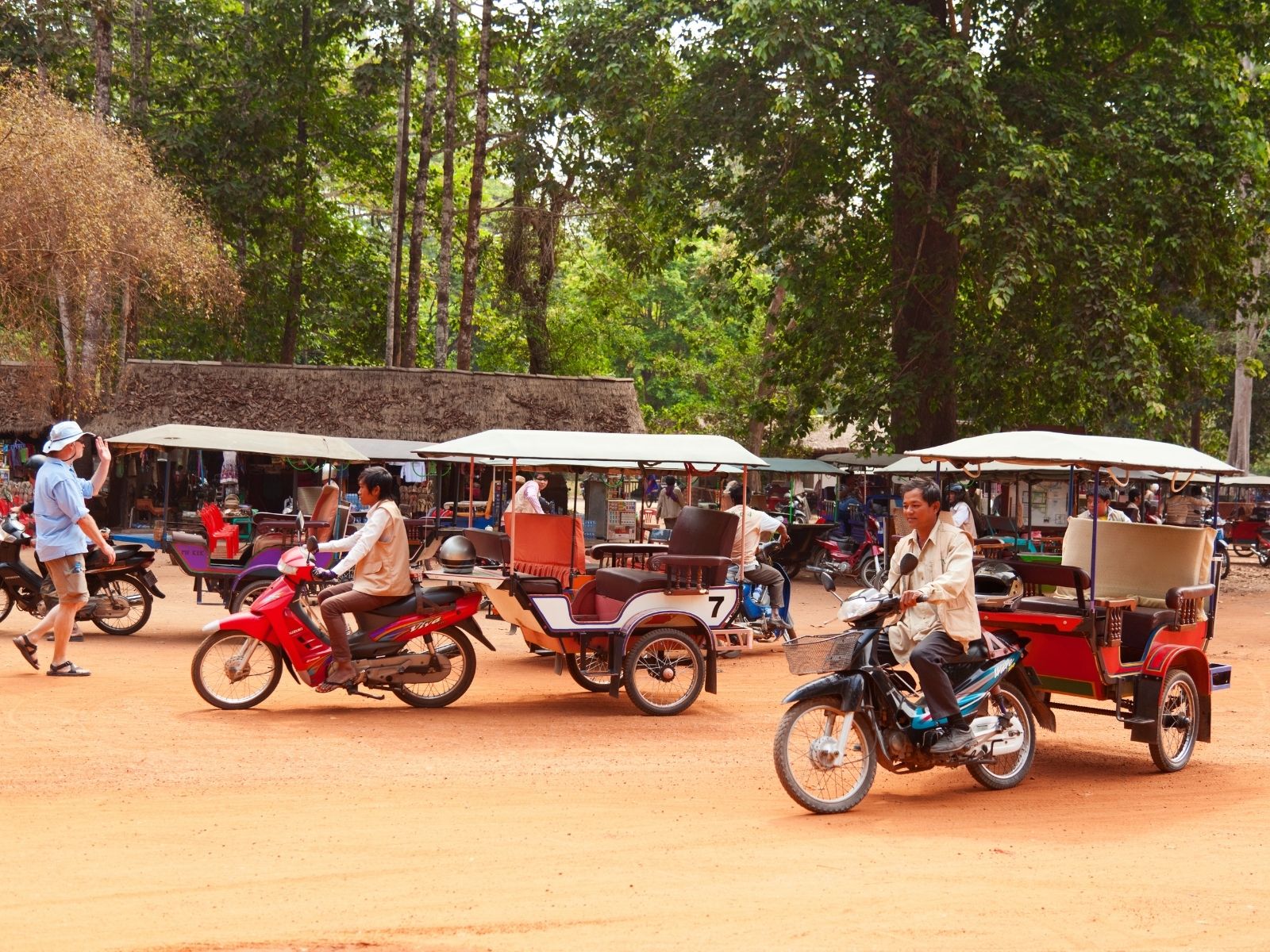
Tuk-Tuks waiting for tourists in and around Angkor Wat ticket office
Understand Angkor Wat's entrance fees in its nitty gritty
The Angkor Wat complex opens at 5 am daily and closes at 6 pm, so plan accordingly. Angkor Wat Complex has a fee for foreign visitors with options of single day, 3-day and 7-day passes depending on your level of interest in exploring this place.
Something to keep in mind here is that the 3-day pass has a validity of 10 days from date of purchase and can be used on 3 different days within the validity period. The 7-day pass has a validity of one month from the date of purchase and can be used on 7 different days within the validity period. You pay everything in US dollars and they do accept credit cards.
The passes need to be obtained at the main entrance ticket office, which is a quick process as they have several counters.The tickets purchased elsewhere are not valid. There is NO online ticket purchase option. The fee is fixed and travel agents do not get any discount, so do not fall into a trap.
The incredible Angkor Wat Temple
One of the perfect ways to start the day is with a beautiful sunrise and if you are an early riser, you will be treated to one of the most spectacular sunrises ever in Angkor Wat. To view this spectacle, I suggest you purchase your ticket the previous evening itself. Don't worry, the validity of the ticket will be active from the next day only. This allows you to head straight to the main temple the next morning to witness the sunrise.
The locals believe that a visit to this temple and your experience is entirely spiritual. I have started believing in this because I have visited the temple several times but unfortunately have not seen the sunrise during any of my visits thanks to the cloud covered skies. The sun played hide and seek with me and it seemed like the rain god probably wanted to lure me into visiting repeatedly. I believe It is truly magical to see the sun emerging from behind Angkor's iconic spires. There are several visitors who come to experience this but trust me the view and the emotions are personal and special to each one.

View of the gates and outer wall enclosure of Angkor Wat from across the moat
Starting early in the day gave us the advantage of beating the heat because as the day progresses, it gets quite humid and hot out there. Also, there were fewer visitors early in the morning which allowed us to leisurely visit the temple. Stock up on food and water before starting out because it will be a long day with a lot of walking, 10 km at the least. After savoring the splendid sunrise, the focus shifts to the incredible structures that one is surrounded by. I always took a moment to just look around and take in the enormity and magnificence of the place. The structures not only embody within them rich history, they also showcase amazing design and architectural skills. It is believed that the construction of Angkor Wat was machine free and took 35 years, 300,000 laborers, and 6,000 elephants. Incredible, right?
The main temple complex is enormous so take your time to visit every part of it as they all tell a unique archeological and architectural story. If you are interested in photography like me, then make sure you give your guide a heads up so that he can plan and prioritize the visiting points accordingly. Also, be careful and mindful of the leechers who hunt for smaller groups with a better guide. At times, they even barge-in and monopolize your guide.

The head of a naga (snake) at the start of the causeway leading to the entrance of Angkor Wat
An architectural wonder of the world
As we started our tour of Angkor Wat Temple, our guide explained that Angkor Wat combines two basic plans of Khmer architecture (also known as Angkorian architecture): the temple-mountain and the galleried temple. The temple-mountain is characterized by its tiered-structure, which represents the mountain that is home to the gods. The galleried temple, on the other hand, has a series of corridors and chambers that are adorned with intricate carvings.
Angkor Wat is surrounded by a moat that is more than 5 km long. This moat not only adds to the beauty of the complex, but it also serves as a symbolic barrier between the earthly world and the world of the gods. A unique feature of the temple is that unlike most other Angkorian temples, Angkor Wat is oriented to the west. This is believed to be because the temple was meant to represent the home of the gods, and the west is considered to be the direction of the afterlife.

This 650-foot-wide moat runs more than 3 miles around Angkor Wat and is believed to stabilize the temple's foundation
The outer wall of the temple consists of three rectangular galleries, each raised above the next. The three galleries represent different levels of heaven, and the temple is adorned with intricate carvings and statues. There is a stunning 3.25 meter statue of Vishnu carved out of a single block of sandstone which had me totally mesmerized. There were several offerings placed here by devotees who visit the place. Historians have admired Angkor Wat for the grandeur and harmony of its architecture. Leading to the main temple is a fascinating 475 feet avenue, lined with naga balustrades. The avenue passes through two beautiful libraries and two refreshing ponds.
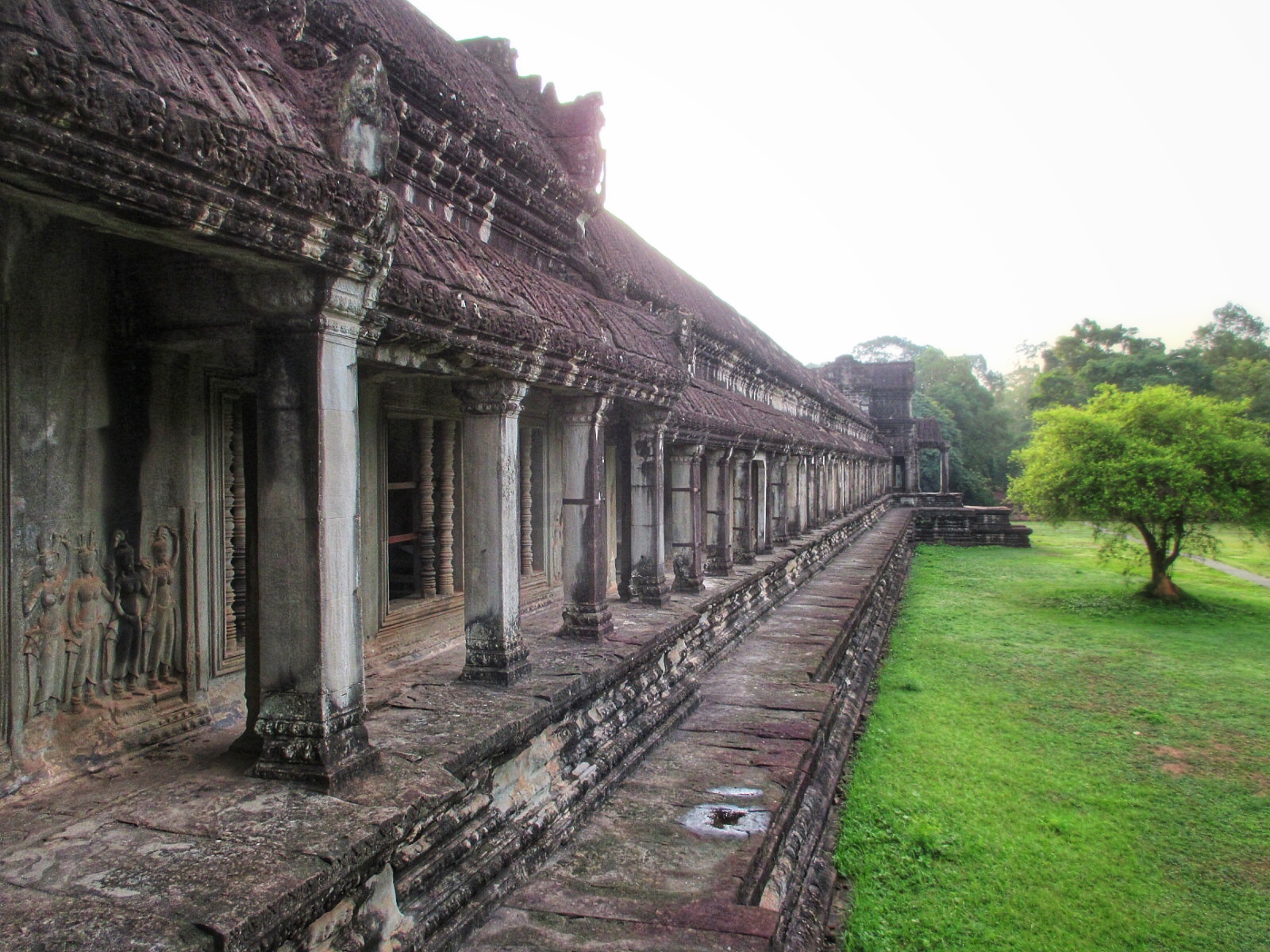
The numerous bas-relief scenes in the outer gallery is an amazing canvas that narrates fascinating stories
The symmetry and detailing of this site is mind blowing and I was walking along almost in a trace, completely captivated by the ambience of the temple surroundings. At the center of Angkor Wat lies a quincunx of towers. This unique five-pointed pattern is created by four towers arranged in a square or rectangle, with a fifth tower at its center.

Uniquely oriented quincunx of towers that stand at the center of the temple showcase the incredible design and craftsmanship of Khmer architecture
This configuration is thought to represent the four cardinal points, with the central tower symbolizing the fifth point, or center, of the quincunx. While the towers symbolize the mountain peaks, the moat symbolizes the ocean. The exact meaning of this symbolism is not known for certain, it is clear that the quincunx played an important role in the design of Angkor Wat.

A tower symbolizing Mount Meru's sacredness
What went into realizing this expansive masterpiece?
It was obvious that Khmer architects were skilled in using sandstone as the main building material, which is why Angkor Wat was largely built with sandstone blocks. It is believed that 5 to 10 million sandstone blocks were used. Laterite was used for the outer wall, and natural resins or slaked lime are believed to be used as binding agents to join the sandstone blocks. The design was intended to create harmony, and it depicts the work of power, utility and style. The use of sandstone is one of the factors that make Angkor Wat such a unique and impressive structure.

View from the top of the central tower of one of the restoration sites with numerous blocks of sandstone that will go into rebuilding
It is characterized by its distinctive Khmer architecture, which includes elements such as ogival towers, lotus-bud cravings, and galleried enclosures. The galleries were built to broaden the passageways and create a sense of spaciousness, whereas the axial galleries connected the various enclosures within the temple. The thousands of decorative storytelling elements of Angkor Wat include apsaras (celestial nymphs), Hindu gods, and bas-reliefs narrating events from Ramayana and Mahabharata. The statuary is considered to be relatively conservative, with most figures representing animals or scenes from daily life. Despite its size and complexity, Angkor Wat was designed to be in harmony with nature.

Apsaras and deities decorate Angkor Wat, there are about 1796 of them

Intricately carved bas relief narrating the battle of Mahabharata
The force behind Angkor Wat
Angkor Wat is believed to have been commissioned by King Suryavarman II in 1116 C.E., just three years after he rose to power. The king's name translates as "sun protector," and it is believed that he chose to construct a temple dedicated to the Hindu god Vishnu, breaking from the Shiva tradition of previous kings. One of the three main deities in the Hindu pantheon is Lord Vishnu (Shiva and Brahma are the others).

Ta Reach Statue at Angkor Wat, an Eight-Armed Vishnu
Scholars believe that Angkor Wat was not only intended to serve as a temple, but also as the king's mausoleum. Construction of the temple ended in 1150, shortly after the king's death, and it is thought that the temple was built to legitimize his claim to political office and the protection and powers of the gods.

One of the many corridors in the gallery with decorated walls
King Jayavarman VII, restored Angkor Wat in the 12th century spanning 2 square kilometers. He then founded a new capital (Angkor Thom) which was the last capital city of the Khmer Empire. The current Angkor Wat complex resides within Angkor Thom. The design of Angkor Thom was adopted from the mythological theme of Samudra Manthan (churning of the ocean). The Chams, the Khmer's traditional enemies, sacked Angkor in 1177. This disturbed King Jayavaram VII leading him to believe that the Hindu gods had failed him. He then turned to Buddhism and as a result, Angkor Wat was converted into a Buddhist temple. It eventually fell into disuse after the 16th century, but it was never completely abandoned.

A view of the innumerable Buddha statues inside Angkor Wat
Restoration efforts of this UNESCO World Heritage Site
For centuries, the ancient city of Angkor was lost to the jungle, its towering temples and magnificent palaces hidden beneath a thick tangle of vines and trees. However, in 1908, work began on the restoration of this once-great city. The Conservation d'Angkor, a French organization, was tasked with clearing away the overgrowth and uncovering the ruins. Over the next few decades, their work gradually revealed the splendor of Angkor. Research and conservation activities were disrupted by the Cambodian Civil War in the 1970s. In 1975, however, the project was abandoned once again when the Khmer Rouge took control of Cambodia.

The resurrected building of Northern Library
The Archaeological Survey of India (ASI) began the process of restoring Angkor Wat in 1986, at the request of Cambodian King Norodom Sihanouk. The work was completed in 1992, and the site was subsequently added to UNESCO's World Heritage Site list. However, due to continued political instability in the region, it was later placed on the organization's World Heritage Danger list. In 2004, after a period of relative stability, Angkor Wat was removed from the danger list and once again recognized as a World Heritage Site.

Outer view of 2-square-kilometer complex showcases the symmetry of Angkor Wat
APSARA (Authority for the Protection of the Site and Management of the Region of Angkor) was established in 1995, after it was determined that the area needed better protection. The organization works to protect and manage the temples and other structures in the region, as well as the surrounding natural environment. In 1996, Cambodia passed a law to further protect its heritage, making it illegal to damage or destroy any of the structures in the area. Thanks to these efforts, Angkor Wat received 2.6 million tourists in 2018 and has now become a symbol of Cambodia, appearing on its national flag.
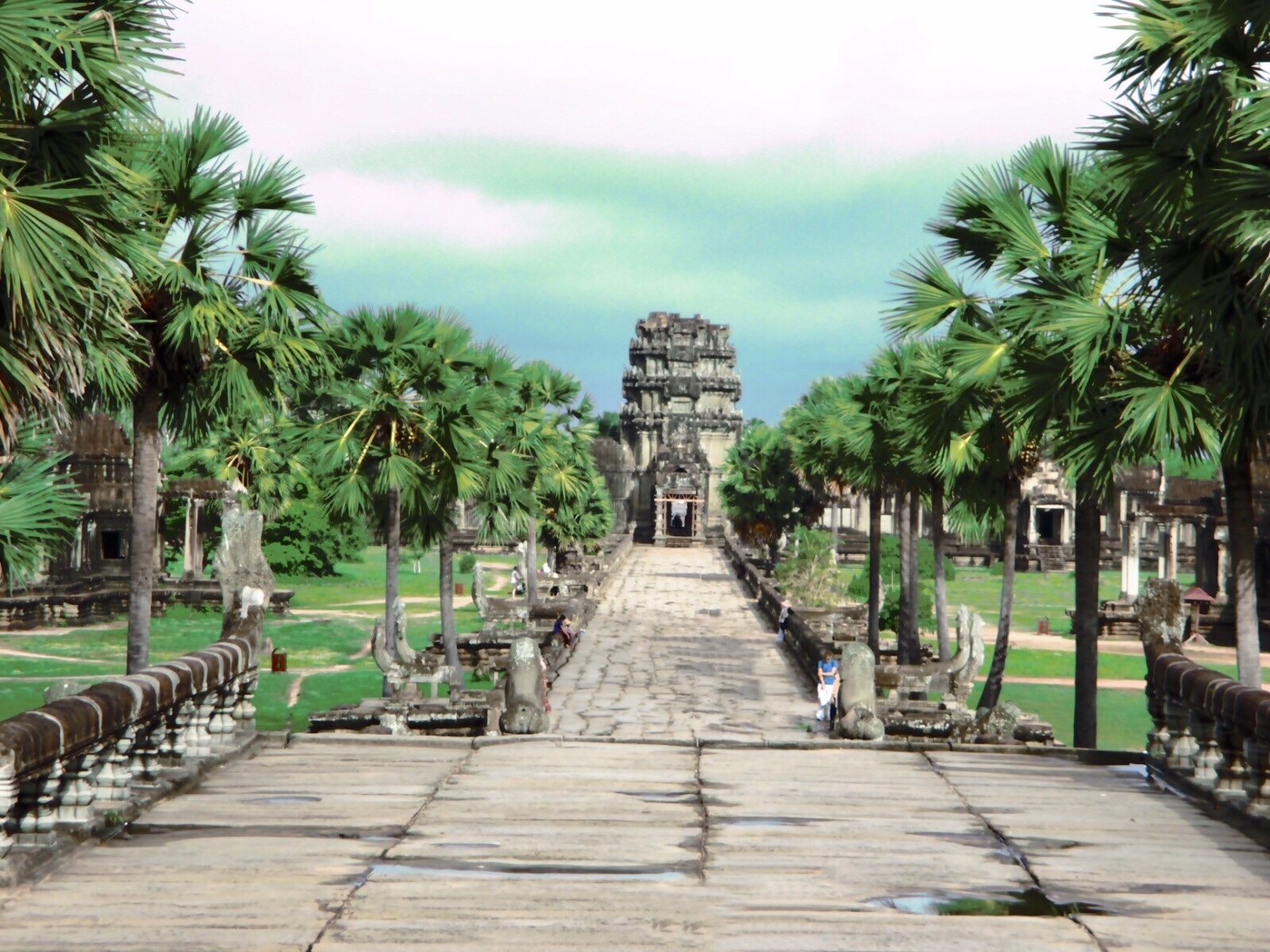
Picture-perfect entrance of Angkor Wat Temple surrounded by lush-green garden and rows of palm trees

The incredible rear view of Angkor Wat was the perfect backdrop for a family picture
A view from the top
After a rather intense morning at the Angkor Wat Temple, we took a small hike to the Lord Shiva temple Phnom Bakheng location atop a hill built by Hindu King Yasovarman in the 9th century. A 30-40 min climb to the top offered a panoramic view of Angkor Wat main temple amid the jungle, Siem Reap city and Angkor Thom which is spectacular. Visitors throng the place in the evening to catch the sunset atop the mountain. It is believed that Phnom Bakheng has a spiritual strength due to which the airplanes don't fly over the mountain.

Stunning landscape view of Angkor Wat Temple from Phnom Bakheng
The phenomenal city of stone
A visit to Angkor Wat Temple is one of the most rewarding and incredible experiences. It takes you to an ancient era of grandeur, splendor and magnanimity of an unimaginable scale. From the 1,200 square meters of carved bas reliefs to the gigantic spires and symmetric architecture, Angkor Wat Temple is one of the most remarkable artistic and architectural wonders of the world.
Frequently Asked Questions:
When was Angkor Wat built?
Suryavarman II built Angkor Wat in Yasodharapura (present-day Angkor), the capital of the Khmer Empire, as his state temple and mausoleum in the early 12th century.
Why is Angkor Wat famous?
Angkor Wat is one of the most famous temples in the world. It is also the largest religious monument in the world, and it is renowned for its intricate carvings and detailed sculptures. The temple is also surrounded by a moat, which adds to its grandeur. Angkor Wat is a popular tourist destination for those interested in history and culture.
Is Angkor Wat worth visiting?
Many people consider Angkor Wat to be one of the most beautiful and mysterious places on earth. The sprawling temple complex, which is located in Cambodia, is a UNESCO World Heritage Site. Many visitors find the temples to be fascinating. If you are interested in learning about different cultures and exploring ancient ruins, then Angkor Wat is definitely worth a visit.
What is the dress code for Angkor Wat?
There is a dress code at Angkor Wat that prohibits revealing clothing, such as garments that expose shoulders, knees, and cleavage. Visitors should wear clothing that covers their shoulders and pants, including skirts below the knee. Read more about Cambodian etiquette.
Do you need to book in advance to visit Angkor Wat?
Fees for visiting Angkor Wat do not need to be paid and booked in advance. There is no limit on the number of visitors allowed per day. Ideally, you should purchase your tickets the previous evening to avoid long queues when it opens in the morning.





























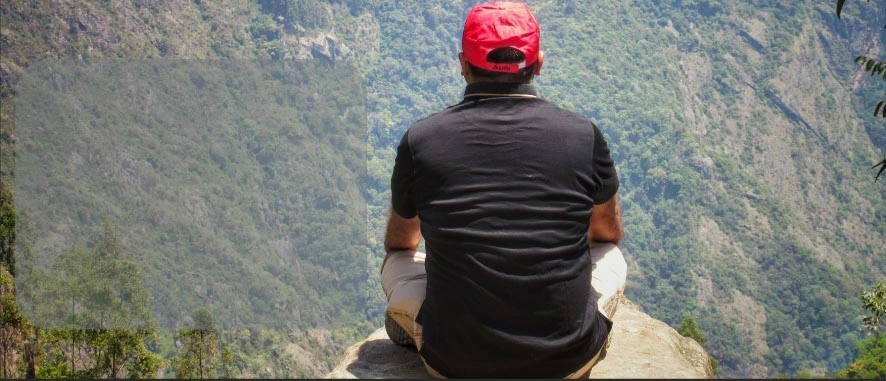

Name
Email
Comment